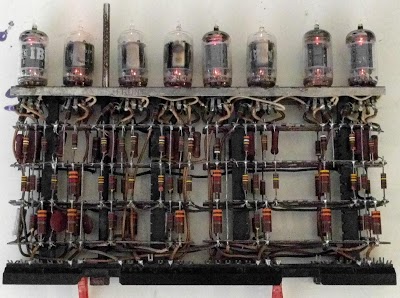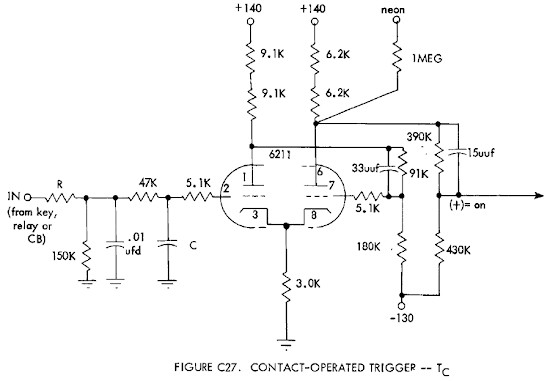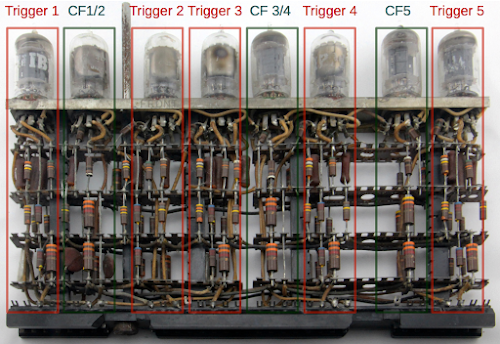The tube bounce suppression module from the IBM 705 computer. What happens if you try to turn it on?
- Transfer
Spoiler: it will suppress the bounce of contacts.

Nowadays, suppression of contact bounce is most often carried out programmatically, but in some cases, hardware methods continue to be used: on RC chains and on triggers. In the 1950s, of course, there was no other choice. A lot of modules like this:

processed the signals from the buttons of such a remote control:

From here
Any complex circuit becomes clear if you break it into simple fragments. This module uses two types of cascades. Below is a slightly simplified diagram of an inverting DC amplifier:

Here, a load resistor is connected between the power plus and the anode of the lamp, so the more it is open, the lower the output voltage. Such an amplifier not only amplifies the voltage, but also inverts.
At the cathode follower, a load resistor is connected between the cathode and the negative voltage source. Its task is, without making changes to the signal amplitude, to provide a low output impedance, and hence a large current carrying capacity.

The author began testing the module by supplying voltage so far only to lamp heaters. To do this, he took a filament transformer (6.3 V, 2.5 A) weighing 1.5 kg.

It turned out that the heaters of all the lamps are working. All of them are double triodes, and each of them lit up both heaters.

With power sources, the anode circuits are more complex. The module requires three voltages: +140, -60 and -130 V, and the input signals are presumably 48-volt (later it turned out that there wasn’t). The existing power supplies provide a maximum of ± 120 V, but the simulation in LTspice showed that at lower voltages everything also works. The author took several power supplies, mostly HP devices from the Marc collection, as well as measuring equipment. Two more PSUs are not visible - they are under the table:

PSUs of the following types are used: 2 pcs. HP3068A (60 V each) - for lines -60 and -120 V, 1 pc. HP6645A - for +120 V, 1 pc. Protek 3003B (modern) - for +30 V (voltage supplied to the input of the chatter suppressor via a button).
The next task is to connect conductors to the module. Corresponding connectors have not been manufactured for 50 years, and soldering should not be done for reasons of authenticity. To the pins of the module came 0.110-inch connectors, reminiscent of FIR.
To switch the supply voltage, as well as send signals from the button, the contact bounce of which you want to suppress, the author made a small remote control:

We now turn to one of the bounce suppression schemes:

In the IBM documentation, it is called a “contact-controlled trigger.” The input signal passes through the low-pass filter, then enters the grid of the first half of the double triode, on which the inverting amplifier is assembled. The inverted signal taken from its load resistor is applied to the grid of the second half of the double triode through a chain of resistors and a capacitor. A negative bias is applied to the same grid through another resistor.
The signal for a neon on the remote control (for which a separate resistor is provided) and a divider, which leads the signal to the following parameters, is removed from the load resistor of this cascade: to the unit corresponds to +30 V, zero -10. The signal then goes to a cathode follower not shown in the diagram, used as a buffer. This allows you to apply it to the inputs of several cascades located in other nodes of the machine.
The cathodes of the lamps are connected together and connected to a common wire through the same resistor. Thanks to this, the circuit acquires the properties of a Schmitt trigger. Three signals are shown on the graph: red - multiple pulses coming from the contact group, green - they are after the low-pass filter, blue - after the Schmitt trigger.

The eight-lamp module under consideration contains five Schmitt triggers (each occupies one double triode), four ordinary cathode repeaters (one double triode - two repeaters) and one repeater with increased load capacity (in it both lamp triodes are connected in parallel). The distribution of functions by lamps is shown below:

For convenience, someone else in those years put red and green marks on the module next to the lamps:

When checking from all the chatter suppression schemes, only the fourth one started working immediately. Of the others, someone slowly took himself resistors as needed. When checking, a neon and an oscilloscope were connected to the corresponding outputs. He also controlled the input signal.

A comparison of the two waveforms shows that bounce is present in the input signal, but not in the output signal. Also, the output signal is shifted relative to the input by 1.3 ms - this has contributed to the low-pass filter.
Then they tried to connect the button to the HP 5334B pulse counter - also vintage, but not so much - directly and through the chatter suppression circuit. The voltage divider, assembled from large resistance stores, the output pulses were "translated" into an understandable counter "five-volt language." With a direct connection of a button, each press of a button takes a counter for several pulses; when connected via a module, for one.
Acknowledgments:
Carl Claunch - for the
Paul Pierce module , bitsavers and the Museum of Computer History - for the preserved documentation for IBM 700 series computers.
The author of one of the comments on the original article wrote that he dismantled such modules in the nineties: he took the lamps for himself, and sold the rest to the craftsman who soldered from them vintage resistors and capacitors for guitar amplifiers. The attitude to vintage as to vintage, and not to a large inexhaustible donor of components, came to mass consciousness only at the beginning of the zero ...

Nowadays, suppression of contact bounce is most often carried out programmatically, but in some cases, hardware methods continue to be used: on RC chains and on triggers. In the 1950s, of course, there was no other choice. A lot of modules like this:

processed the signals from the buttons of such a remote control:

From here
Any complex circuit becomes clear if you break it into simple fragments. This module uses two types of cascades. Below is a slightly simplified diagram of an inverting DC amplifier:

Here, a load resistor is connected between the power plus and the anode of the lamp, so the more it is open, the lower the output voltage. Such an amplifier not only amplifies the voltage, but also inverts.
At the cathode follower, a load resistor is connected between the cathode and the negative voltage source. Its task is, without making changes to the signal amplitude, to provide a low output impedance, and hence a large current carrying capacity.

The author began testing the module by supplying voltage so far only to lamp heaters. To do this, he took a filament transformer (6.3 V, 2.5 A) weighing 1.5 kg.

It turned out that the heaters of all the lamps are working. All of them are double triodes, and each of them lit up both heaters.

With power sources, the anode circuits are more complex. The module requires three voltages: +140, -60 and -130 V, and the input signals are presumably 48-volt (later it turned out that there wasn’t). The existing power supplies provide a maximum of ± 120 V, but the simulation in LTspice showed that at lower voltages everything also works. The author took several power supplies, mostly HP devices from the Marc collection, as well as measuring equipment. Two more PSUs are not visible - they are under the table:

PSUs of the following types are used: 2 pcs. HP3068A (60 V each) - for lines -60 and -120 V, 1 pc. HP6645A - for +120 V, 1 pc. Protek 3003B (modern) - for +30 V (voltage supplied to the input of the chatter suppressor via a button).
The next task is to connect conductors to the module. Corresponding connectors have not been manufactured for 50 years, and soldering should not be done for reasons of authenticity. To the pins of the module came 0.110-inch connectors, reminiscent of FIR.
To switch the supply voltage, as well as send signals from the button, the contact bounce of which you want to suppress, the author made a small remote control:

We now turn to one of the bounce suppression schemes:

In the IBM documentation, it is called a “contact-controlled trigger.” The input signal passes through the low-pass filter, then enters the grid of the first half of the double triode, on which the inverting amplifier is assembled. The inverted signal taken from its load resistor is applied to the grid of the second half of the double triode through a chain of resistors and a capacitor. A negative bias is applied to the same grid through another resistor.
The signal for a neon on the remote control (for which a separate resistor is provided) and a divider, which leads the signal to the following parameters, is removed from the load resistor of this cascade: to the unit corresponds to +30 V, zero -10. The signal then goes to a cathode follower not shown in the diagram, used as a buffer. This allows you to apply it to the inputs of several cascades located in other nodes of the machine.
The cathodes of the lamps are connected together and connected to a common wire through the same resistor. Thanks to this, the circuit acquires the properties of a Schmitt trigger. Three signals are shown on the graph: red - multiple pulses coming from the contact group, green - they are after the low-pass filter, blue - after the Schmitt trigger.

The eight-lamp module under consideration contains five Schmitt triggers (each occupies one double triode), four ordinary cathode repeaters (one double triode - two repeaters) and one repeater with increased load capacity (in it both lamp triodes are connected in parallel). The distribution of functions by lamps is shown below:

For convenience, someone else in those years put red and green marks on the module next to the lamps:

When checking from all the chatter suppression schemes, only the fourth one started working immediately. Of the others, someone slowly took himself resistors as needed. When checking, a neon and an oscilloscope were connected to the corresponding outputs. He also controlled the input signal.

A comparison of the two waveforms shows that bounce is present in the input signal, but not in the output signal. Also, the output signal is shifted relative to the input by 1.3 ms - this has contributed to the low-pass filter.
Then they tried to connect the button to the HP 5334B pulse counter - also vintage, but not so much - directly and through the chatter suppression circuit. The voltage divider, assembled from large resistance stores, the output pulses were "translated" into an understandable counter "five-volt language." With a direct connection of a button, each press of a button takes a counter for several pulses; when connected via a module, for one.
Acknowledgments:
Carl Claunch - for the
Paul Pierce module , bitsavers and the Museum of Computer History - for the preserved documentation for IBM 700 series computers.
The author of one of the comments on the original article wrote that he dismantled such modules in the nineties: he took the lamps for himself, and sold the rest to the craftsman who soldered from them vintage resistors and capacitors for guitar amplifiers. The attitude to vintage as to vintage, and not to a large inexhaustible donor of components, came to mass consciousness only at the beginning of the zero ...
